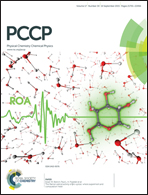Finite lattice model for molecular aggregation equilibria. Boolean statistics, analytical approximations, and the macroscopic limit†
Abstract
Molecular processes, ranging from hydrophobic aggregation and protein binding to mesoscopic self-assembly, are typically driven by a delicate balance of energetic and entropic non-covalent interactions. Here, we focus on a broad class of such processes in which multiple ligands bind to a central solute molecule as a result of solute–ligand (direct) and/or ligand–ligand (cooperative) interaction energies. Previously, we described a weighted random mixing (WRM) mean-field model for such processes and compared the resulting adsorption isotherms and aggregate size distributions with exact finite lattice (FL) predictions, for lattices with up to n = 20 binding sites. Here, we compare FL predictions obtained using both Bethe–Guggenheim (BG) and WRM approximations, and find that the latter two approximations are complementary, as they are each most accurate in different aggregation regimes. Moreover, we describe a computationally efficient method for exhaustively counting nearest neighbors in FL configurations, thus making it feasible to obtain FL predictions for systems with up n = 48 binding sites, whose properties approach the thermodynamic (infinite lattice) limit. We further illustrate the applicability of our results by comparing lattice model and molecular dynamics simulation predictions pertaining to the aggregation of methane around neopentane.


 Please wait while we load your content...
Please wait while we load your content...